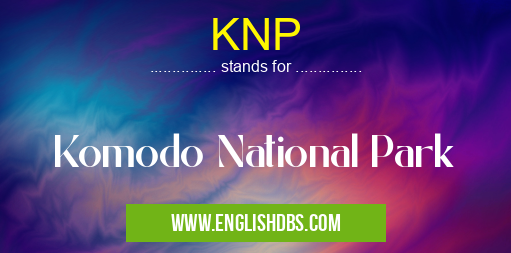What does KNP mean in PARKS
KNP is an acronym that stands for Komodo National Park. It is a national park located in Indonesia, established in 1980 to protect the unique flora and fauna of the Komodo Islands.

KNP meaning in Parks in Community
KNP mostly used in an acronym Parks in Category Community that means Komodo National Park
Shorthand: KNP,
Full Form: Komodo National Park
For more information of "Komodo National Park", see the section below.
Full Form
- K: Komodo
- N: National
- P: Park
Significance
KNP is renowned for its exceptional biodiversity, particularly for being the habitat of the iconic Komodo dragon, the world's largest living lizard. The park encompasses three major islands: Komodo, Rinca, and Padar, along with numerous smaller islands.
UNESCO World Heritage Site
In 1991, KNP was designated as a UNESCO World Heritage Site in recognition of its outstanding universal value as a natural ecosystem of global importance. It is home to a diverse range of marine and terrestrial species, including over 1,000 plant species, 380 bird species, and 27 mammal species.
Tourism and Conservation
KNP is a popular tourist destination, attracting visitors from around the world who come to observe the Komodo dragons and experience the park's pristine natural environment. However, the park also faces challenges related to tourism management and conservation efforts to protect its delicate ecosystem.
Essential Questions and Answers on Komodo National Park in "COMMUNITY»PARKS"
What is Komodo National Park (KNP)?
KNP is a UNESCO World Heritage Site located in Indonesia's Lesser Sunda Islands, renowned for its population of Komodo dragons, the world's largest lizards. It encompasses three major islands (Komodo, Rinca, and Padar) and numerous smaller ones, covering an area of approximately 1,800 square kilometers. KNP is home to diverse ecosystems, including coral reefs, mangrove forests, and savanna grasslands.
When is the best time to visit KNP?
The best time to visit KNP is during the dry season from April to October. During this time, the weather is generally sunny and dry, making it ideal for wildlife viewing and trekking. However, it is important to note that the park is open year-round.
How do I get to KNP?
The main gateway to KNP is Labuan Bajo on the island of Flores. From Labuan Bajo, you can take a boat to Komodo Island, which is the largest island in the park. There are regular boat services available from Labuan Bajo to Komodo Island, with the journey taking approximately 2-3 hours.
What activities can I do in KNP?
KNP offers a range of activities for visitors, including:
- Wildlife viewing: Observe Komodo dragons, as well as other wildlife such as deer, pigs, and birds.
- Trekking: Explore the park's diverse landscapes, including savannas, rainforests, and beaches.
- Snorkeling and diving: Discover the pristine coral reefs and marine life in the park's waters.
- Cultural tours: Visit local villages and learn about the culture and traditions of the Komodo people.
What are the park entrance fees?
The entrance fees for KNP vary depending on the length of your stay and the activities you plan to engage in. For a 1-day visit, the entrance fee is approximately 250,000 Indonesian Rupiah (IDR). For a 3-day visit, the fee is approximately 500,000 IDR. Additional fees may apply for specific activities, such as ranger-guided treks or boat tours.
What safety precautions should I take when visiting KNP?
When visiting KNP, it is important to take the following safety precautions:
- Always stay with a ranger when exploring the park.
- Do not approach or feed Komodo dragons, as they are wild animals and can be dangerous.
- Wear sturdy shoes and comfortable clothing, as the terrain can be challenging.
- Bring plenty of water and sunscreen, as the sun can be intense.
- Be aware of your surroundings and report any suspicious activity to park rangers.
Final Words: KNP (Komodo National Park) is a vital conservation area that safeguards a unique and irreplaceable natural heritage. Its designation as a UNESCO World Heritage Site highlights its global significance and the importance of preserving its biodiversity for future generations.
